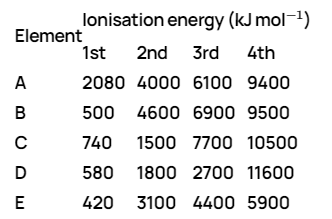The most basic oxide of elements group 14 of the periodic table is:
SiO2
GeO2
SnO2
PbO
The correct Answer is:D
To determine the most basic oxide of the elements in Group 14 of the periodic table, we need to analyze the basic nature of the oxides formed by these elements: SiO2, GeO2, SnO2, and PbO.
1. Identify Group 14 Elements:
- The elements in Group 14 are Carbon (C), Silicon (Si), Germanium (Ge), Tin (Sn), and Lead (Pb).
2. List the Oxides:
- The oxides corresponding to these elements are:
- Carbon: CO2
- Silicon: SiO2
- Germanium: GeO2
- Tin: SnO2
- Lead: PbO
3. Understand Basicity of Oxides:
- Basicity refers to the ability of an oxide to react with acids to form salts and water. Basic oxides tend to be formed by metals, while acidic oxides are typically formed by non-metals.
4. Trend in Basicity:
- As we move down the group from Carbon to Lead, the metallic character of the elements increases. This increase in metallic character generally correlates with an increase in basicity of their oxides.
5. Compare the Oxides:
- SiO2 and GeO2 are more acidic in nature due to the non-metallic character of Silicon and Germanium.
- SnO2 and PbO are more basic because Tin and Lead are more metallic compared to Silicon and Germanium.
- Among these, PbO (Lead oxide) is the most basic because Lead is the heaviest and most metallic element in Group 14.
6. Conclusion:
- Therefore, the most basic oxide of the elements in Group 14 is PbO.
Final Answer:
The most basic oxide of elements in Group 14 of the periodic table is PbO (Lead oxide).
---
- The elements in Group 14 are Carbon (C), Silicon (Si), Germanium (Ge), Tin (Sn), and Lead (Pb).
- The oxides corresponding to these elements are:
- Carbon: CO2
- Silicon: SiO2
- Germanium: GeO2
- Tin: SnO2
- Lead: PbO
- Basicity refers to the ability of an oxide to react with acids to form salts and water. Basic oxides tend to be formed by metals, while acidic oxides are typically formed by non-metals.
- As we move down the group from Carbon to Lead, the metallic character of the elements increases. This increase in metallic character generally correlates with an increase in basicity of their oxides.
- SiO2 and GeO2 are more acidic in nature due to the non-metallic character of Silicon and Germanium.
- SnO2 and PbO are more basic because Tin and Lead are more metallic compared to Silicon and Germanium.
- Among these, PbO (Lead oxide) is the most basic because Lead is the heaviest and most metallic element in Group 14.
- Therefore, the most basic oxide of the elements in Group 14 is PbO.
The most basic oxide of elements in Group 14 of the periodic table is PbO (Lead oxide).
Topper's Solved these Questions
- p-BLOCK ELEMENTSBOOK - VK JAISWAL ENGLISHCHAPTER - p-BLOCK ELEMENTSEXERCISE - LEVEL 3 (PASSAGE TYPE)
17 Videos
- p-BLOCK ELEMENTSBOOK - VK JAISWAL ENGLISHCHAPTER - p-BLOCK ELEMENTSEXERCISE - ONE OR MORE ANSWERS IS/ARE CORRECT
95 Videos
- p-BLOCK ELEMENTSBOOK - VK JAISWAL ENGLISHCHAPTER - p-BLOCK ELEMENTSEXERCISE - SUBJECTIVE PROBLEMS
35 Videos
- METALLURGYBOOK - VK JAISWAL ENGLISHCHAPTER - METALLURGYEXERCISE - ASSERTION-REASON TYPE QUESTIONS
29 Videos
- PERIODIC PROPERTIESBOOK - VK JAISWAL ENGLISHCHAPTER - PERIODIC PROPERTIESEXERCISE - MATCH THE COLUMN
11 Videos
Similar Questions
Knowledge Check
Which is true for an element present in group 13 of the periodic table?
AIt is a gas at room temperature.BIt has oxidation state of +4.CIt forms R2O3.DIt forms RX2.
Name all the elements of group 14 of periodic table.
View SolutionState true or false: The elements of group 17 of the periodic table are called halogens.
View SolutionName all the elements of group 15 of periodic table.
View SolutionName all the elements of group 16 of periodic table.
View SolutionWhat is the total number of elements in the I group of the modern periodic table
View SolutionAn element belongs to 3rd period and group 13 of the periodic table. Which of the following properties will be shown by the element ?
View SolutionFollowing table shows the successive molar ionization energy ( kJ mol−1) of five elements A to E.

Which two elements are most likely to be in the same group of the periodic table?
View Solution
